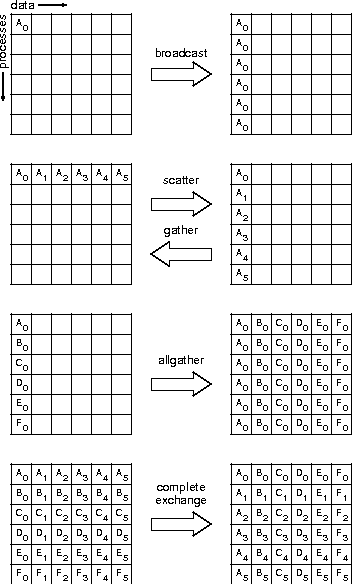
Collective communication is defined as communication that involves a group or groups of processes. The functions of this type provided by MPI are the following:

One of the key arguments
in a call to a collective routine
is a communicator that defines the group
or groups
of participating processes and provides a context for the operation.
This is discussed further in Section Communicator Argument
.
The syntax and semantics of the collective operations are
defined to be consistent with the syntax and semantics of the
point-to-point operations. Thus, general datatypes are allowed
and must match between sending and receiving processes as specified
in
Chapter Datatypes
.
Several collective routines such as broadcast and gather have
a single originating or receiving process.
Such a process is
called the root.
Some arguments in the collective functions are specified as
``significant only at root,'' and are ignored for all
participants except the root.
The reader is referred to Chapter Datatypes
for information concerning communication buffers,
general datatypes and type matching rules, and to
Chapter Groups, Contexts, Communicators, and Caching
for information on how to define groups and
create communicators.
The type-matching conditions for the collective operations are more
strict than the corresponding conditions between sender and receiver
in point-to-point. Namely, for collective operations,
the amount of data sent must exactly
match the amount of data specified by the receiver.
Different
type maps (the layout in memory, see Section Derived Datatypes
)
between sender and receiver are still allowed.
Collective routine calls can (but are not required to) return as soon as their
participation in the collective communication is complete. The completion
of a call indicates that the caller is now free to modify locations in thecommunication buffer. It does not indicate that other processes in
the group have completed or even
started the operation (unless otherwise
implied bythe description of the operation).Thus, a collective communication call may, or
may not, have the effect of synchronizing all calling processes.
This statement excludes, of course, the barrier function.
Collective communication calls may use the same
communicators as point-to-point communication; MPI guarantees that
messages generated on behalf of collective communication calls will not
be confused with messages generated by point-to-point communication.
A more detailed discussion of correct use of collective
routines is found in Section Correctness
.
The equal-data restriction (on type matching) was made so
as to avoid the complexity
of providing a facility analogous to the status
argument of MPI_RECV for discovering the amount of data sent.
Some of the collective routines would require an array of status values.
The statements about synchronization are made so as to allow a variety
of implementations of the collective functions.
The collective operations do not accept a message tag argument.
If future revisions of MPI define nonblocking collective functions,then tags (or a similar mechanism)
might
need to be added so as
to allow the dis-ambiguation of multiple, pending, collective operations.
( End of rationale.)
It is dangerous to rely on synchronization
side-effects of the collective operations for program correctness.
For example, even though a particular implementation may
provide a broadcast routine
with a side-effect of synchronization, the standard does not require
this, and a program that relies on this will not be portable.
On the other hand, a correct, portable program must allow for the fact
that a collective call may be synchronizing. Though one cannot
rely on any synchronization side-effect, one must program so as to allow
it. These issues are discussed further in Section Correctness
.
( End of advice to users.)
While vendors may write optimized collective routines matched to
their architectures, a complete library of the collective communication
routines can be written entirely using the MPI point-to-point communication
functions and a few auxiliary functions. If implementing on top of
point-to-point, a hidden, special communicator
might
be created for the
collective operation so as to avoid interference with any on-going
point-to-point communication at the time of the collective call. This
is discussed further in Section Correctness
.
( End of advice to implementors.)
Figure 1: Collective move functions illustrated
for a group of six processes. In each case, each row of boxes
represents data locations in one process. Thus, in the broadcast,
initially just the first process contains the data $A_0$, but after the
broadcast all processes contain it.
Rationale.
Advice to users.
Advice
to implementors.
Many of the descriptions of the collective routines provide illustrations in
terms of blocking MPI point-to-point routines. These are intended solely to
indicate what data is sent or received by what process. Many of these
examples
are not correct MPI programs; for purposes of simplicity, they often
assume infinite buffering.
![]()
![]()
![]()
Up: Contents
Next: Communicator Argument
Previous: Collective Communication
Return to MPI-2.2 Standard Index
Return to MPI Forum Home Page
(Unofficial) MPI-2.2 of September 4, 2009
HTML Generated on September 10, 2009